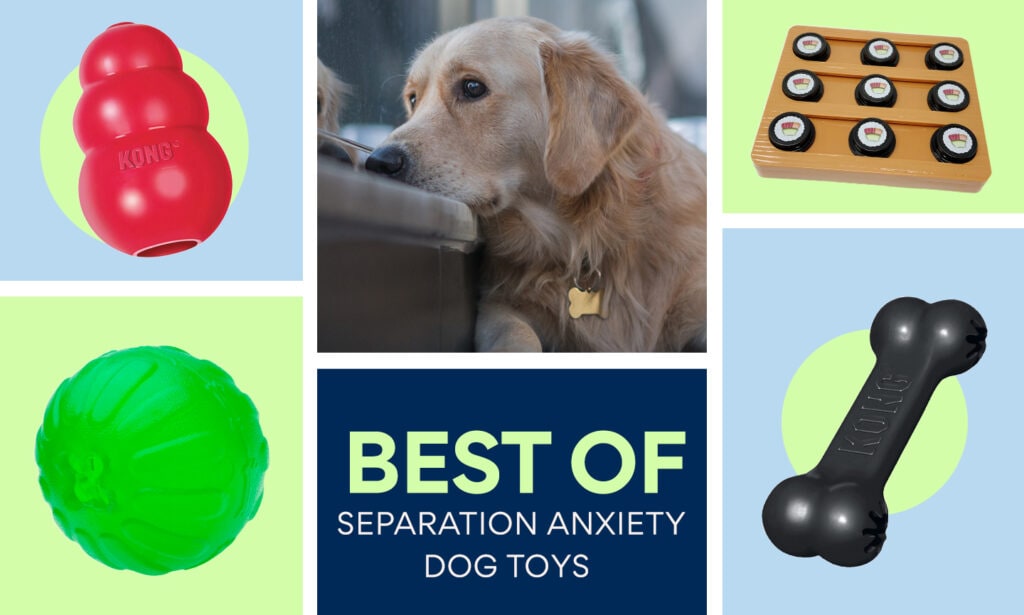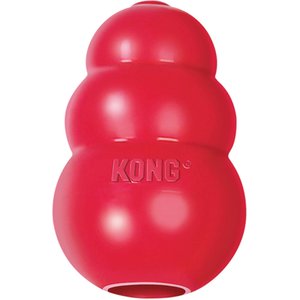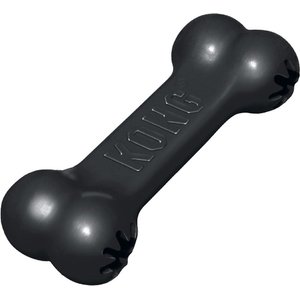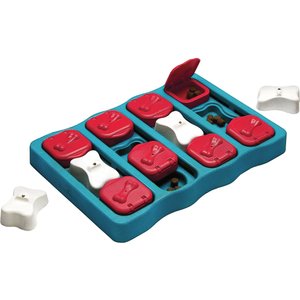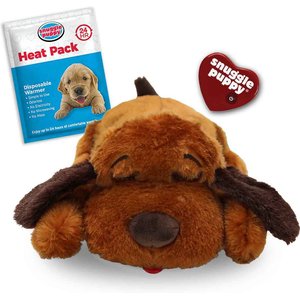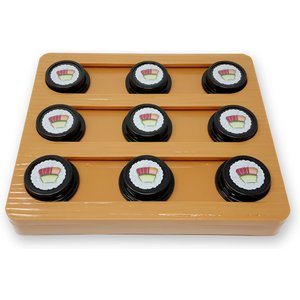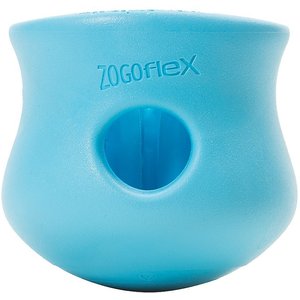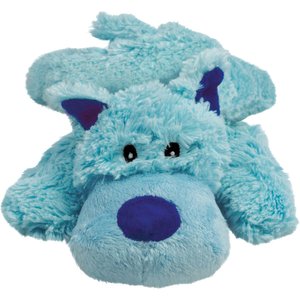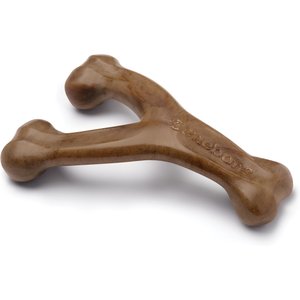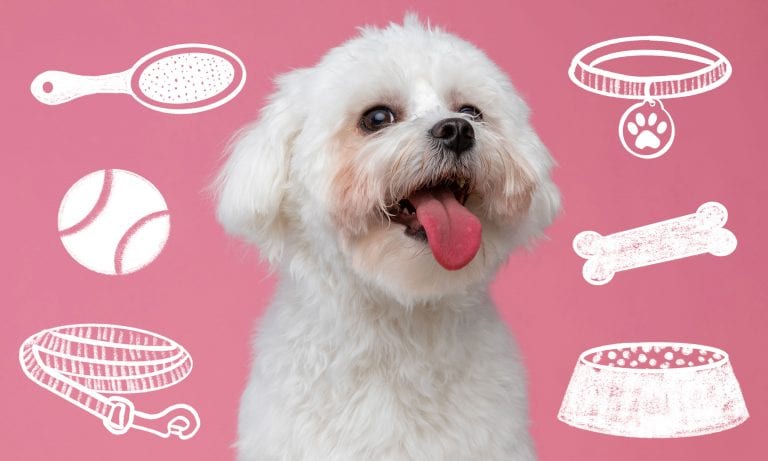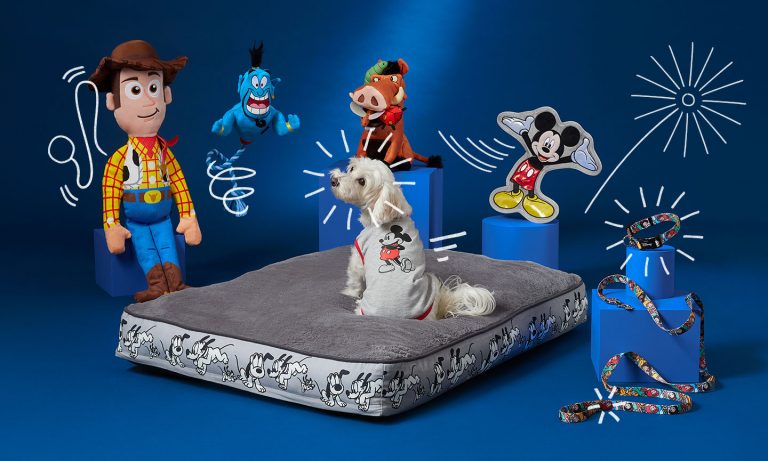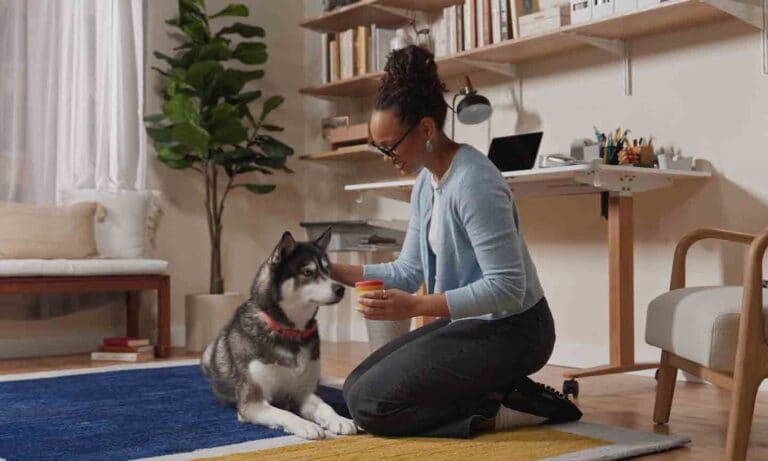If your dog gets stressed out when you’re apart, one way you can help them out is with separation anxiety dog toys. From soothing softies for snuggling to puzzles and games that keep their brain enagaged, dog toys for separation anxiety can help your pooch feel more relaxed while you’re away. To get you started, we’ve rounded up some of the best dog toys for separation anxiety as tried and tested by Chewy pet parents like you. These top-rated, best-selling toys for dogs with separation anxiety are specially designed to help anxious pups cope better with time away from their favorite humans.
Just remember, always consult with your veterinarian or a qualified behaviorist as well—dog toys for separation anxiety are one tool to help with separation anxiety, but anxious dogs may need some medical help and dog training to work through their anxiety.
- 1
- 2
- 3
- 4
- 5
-
Great for Chewing
We use this for a chew toy. My German Shepherds love to chew and fetch this Kong. They have not yet destroyed any part of this though they have smaller ones. I do not put food in it.
-
More durable than most
This Kong is more durable than most treat filler toys and has managed to survive a couple of weeks with my super chewing GSD.
-
Perfect for enrichment
My dog loves this one, I have many of them and make sure to put them on the freezer for a quick enrichment snack!
-
Jesse loves this ball.
Jesse loves the ball. Especially when it's filled with peanut butter. It kept him busy when my Bible Study Group was at our home
-
Indestructible
After my dog destroyed a different treat ball within 24 hours - Chewy suggested this one . It’s been several days now and both dogs love it and it’s still intact.
-
durable
Great ball got one for my previous dog so got one for my new dog but he kept getting his jaw stuck in it so I can't use it for treats anymore.
-
Kong always makes a good product
We bought kong in the past they are always durable I have one black know bone that lasted over 10 years. I have heavy chewers. Siberian huskies
-
Sturdy good toy
My small but powerful pooch does not destroy this item when we treat-load it to keep her busy when leaving the house.
-
Sturdy and good for heavy chewers.
My dog loves the Nylabone type chews, but was managing to chew and eat small pieces from it, so decided this would be a safer option. She loves it and chews vigorously on it and it doesn't have a mark on it.
-
Helped 2 dogs--one eating too fast and the other not wanting to eat
One dog ate too fast and this slowed him down--at least for a short time but he still likes itThe second dog did not want to eat, but after introducing her to this puzzle she found it fun and ate all of her food that was hidden in it
-
Variety of games and difficulty levels
My pups love these puzzles. Warning, game-playing is not a “quiet” activity in our home. They haven’t broken anything with all of their paw pounding and excitement.
-
Engaging
Usually takes my dog a little bit to find everything. He's a bit more muscles over mind, so pieces end up everywhere, but it's very easy to reattach the covers.
-
Snuggle puppy
We got a snuggle puppy when she was 8 weeks old. She is now 11 months old and still carry’s it around. I ordered this one because the other one is a little dirty and I had to cut the ears off and tail but she love it !
-
Stressed puppy
We started using Snuggle Puppy at night to help settle our anxious 8 week old puppy. It works like a charm.
-
Easy first night for baby pup
My new little 2 lb toy poodle had a very easy 1st night by laying on top of this heartbeat pup. Now that she's past needing the heartbeat as comfort, she uses it as a playmate and wrestles it. It's pretty cute!
-
Sushi puzzle feeder
My cat mastered this puzzle very quickly. I think I like it more than him. It is a cute puzzle. I think kittens could handle this one.
-
Intelligence and memory booster.
My dog loves this puzzle dog feeder. He feeds on this in the middle of the night like a snack. I always keep it filled.
-
Very cute!
My daughter’s kitty loved this food puzzle - she was quick to figure it out but was kept occupied for a little while.
-
Great for mild chewers
My husky loves to eat her fresh food out of this. She’s 45 lbs and is a mild chewer. However, my 60 lb german shepherd would destroy this. It’s definitely not for tough chewers.
-
It works!
My dog gobbles his food in seconds flat. I packed his topple with his food and a few treats buried inside and he was busy for almost 20 minutes! I think he even had fun :)
-
Perfect Size
I fill these with canned dog food and place them in the freezer in a zip lock bag. Fido loves having a treat every night when I have my treat after dinner.
-
Active Doodle Entertainment
My doodle is not easily entertained. She doesn't like bones, hard chews (even if flavored), balls with peanut butter in them, you name it. This is the only game that has kept her busy (obviously she is traditional treat motivated). Easy to clean in washing machine.
-
Fabulous Enrichment Toy for my dog!
My dog loves this mat! Soft and large for my 13 pound dog. I am so happy with this purchase. The highest recommend!
-
All the fancy places to search for treats
As I mentioned in the title, plus the crinkly sounding base, but I wish there was less felt and velcro areas, he likes to rip that off. We've had three of these in the last two years. It's his favorite puzzle of the many we have. (We'll need to start looking for harder ones soon)
-
Favorite!
This is our dog's favorite toy after having it for over a year, and having sooo many other toys! He loves this one so much!
-
Blue dog
I bought this for my dog for Christmas so I can't really leave a review but I can say Kong toys are very durable
-
My new puppy loves this toy.
Maggie is 6 months old and is loving this toy so much she has forgotten to chew on my furniture!
-
Almost indestructible!
Our pity can destroy any toy or bone. But there’s been a bone has lasted longer than almost any. Even our husky loves them.
-
the design
Both my dogs enjoyed this bone. They did not destroy it as they have other bones. Very satisfied with this bone.
What are the signs of separation anxiety in dogs?
Signs of separation anxiety in dogs that you should be on the lookout for, according to Dr. Jennifer Summerfield, DVM CPDT-KA, a veterinarian and professional dog trainer:
- Potty accidents that only happen when you aren’t home
- Destructive behaviors like chewing on things or pawing at walls or doors
- Reports from neighbors that your dog is barking, whining, howling or making other noises while you’re away
- Treats or food that aren’t eaten while you’re gone—that your dog may then eat right away when you get home
- Excessive drooling when you’re gone
- Pacing or restlessness
If you’re concerned that your dog may have separation anxiety, Dr. Summerfield recommends using a dog camera to watch or record what your dog is doing while you’re gone. She says recording your dog’s actual behavior rather than relying on whatever circumstantial evidence you find when you get home can help distinguish between a pup with true separation anxiety and a dog who might just be bored and destructive.
How do toys help with separation anxiety in dogs?
Certain dog toys, like those you stuff with treats, can be helpful for many dogs with separation anxiety issues because they “help keep the dog happily occupied for a while, and also start teaching them that staying home alone isn’t such a bad deal since that’s when the really good stuff comes out,” Dr. Summerfield explains.
She often recommends some sort of extra-special, long-lasting treat like a stuffed KONG or Twist’nTreat filled with peanut butter, spray cheese or canned dog food whenever they leave the house. Freezing these types of toys after stuffing them helps them last longer.
Be aware, though, that many dogs will initially be too anxious to have any interest in toys or treats while they’re home alone. In these cases, Dr. Summerfield says anti-anxiety medication from your veterinarian can make a big difference, so she always recommends getting your dog’s veterinarian involved as part of the process.
Tips for Introducing a New Dog Toy for Separation Anxiety
You should always supervise your dog when giving them a new separation anxiety toy. Start by giving your dog their new toy while supervised, then take short trips away to get them used to the idea of you being gone.
Keep in mind that different types of separation anxiety toys will be better for certain pups—snuggle bugs who aren’t big chewers may love a soft plushy or easy lick mat while frisky pooches with lots of energy to burn may need a more challenging puzzle game or durable chew toy.
What are other ways to help separation anxiety in dogs?
1. Talk to your veterinarian about medication for separation anxiety.
According to Dr. Summerfield, medication is one way that you can really help your dog work through their separation anxiety. “Separation anxiety is one behavioral issue that’s really, really hard to make progress on without some anti-anxiety meds on board, since your dog is essentially having a panic attack every time you leave the house,” she says.
When your pup is super upset because of a stressful situation, they’re not able to learn new or better behaviors, so Dr. Summerfield says she often finds medication is a helpful part of the initial treatment plan to help make headway on changing their feelings. Pet parents can consult with their veterinarian or set up a consultation with a veterinary behaviorist to talk through the different options available, and help you decide if medication would be a good idea for your dog.
2. Keep comings and goings as calm and low-key as possible.
Don’t make a big production of saying goodbye to your dog or make a huge fuss over them as soon as you get home. According to Dr. Summerfield, “That just highlights the contrast between how fun and awesome it is when you’re home, and how quiet and lonely the house is when you’re gone.” Instead, keep calm when leaving or returning home to help your dog get used to the idea that this is a normal, everyday activity.
3. Don’t punish or scold your pup for potty accidents or destructive behavior.
“Dogs are very literal—they live in the moment and don’t understand the concept of being scolded for something that happened hours, or even minutes, ago,” says Dr. Summerfield. Additionally, if your dog learns that you’re upset with them when you get home, this can increase your pet’s anxiety and make them feel more concerned about the whole situation. Instead, practice rewarding calm behavior and set up a training schedule to help work through the events that trigger your dog’s anxiety—like the sound of your car keys or the sight of you putting on your jacket.
4. Create a safe zone for your dog to relax when you’re away.
Dr. Summerfield says that in her experience, most dogs with separation anxiety do better with less confinement. “If you can safely leave your dog loose in the house or even in a gated off portion of the house, this is often a better option than crating,” she says. Set up their safe space with a comfy bed, fresh water and their favorite calming dog toys. Start with short trial runs, with a camera set up so you can see what your dog is doing. If they start to become destructive or get into trouble, you can come back and help positively redirect their behavior. Practice short absences first and slowly build up to longer times away from your dog.
Looking for other ways to help you anxious pup in addition to the best separation anxiety dog toys? Check out our comprehensive guide on separation anxiety in dogs for more tips and pointers on how to help your dog stress less and relax more—even when you’re not at home.
Learn more about how your best bud can keep calm and tail wag on:
Share:
